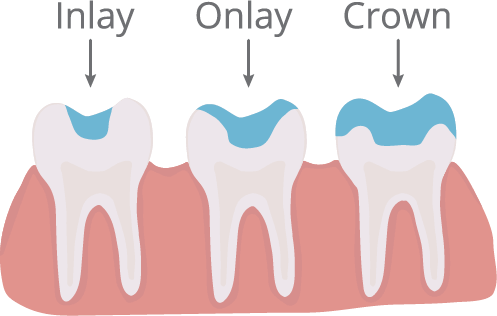Inlays and Onlays
A conservative option to restore molar teeth with a large cavity
Less costly than a dental crown and more durable than most dental fillings, Dental Inlays and Onlays are used to restore large cavities without having to use a crown


Our Cosmetic Dentist in Buford, GA may recommend Dental Inlays or Onlays when your tooth cannot support a filling but is not severe enough for a dental crown. In this case, capping the damaged tooth with a dental crown would remove more tooth structure than necessary. On the other hand, a large dental filling can weaken the remaining structure of the tooth, which could eventually cause it to break, crack, or require a root canal. Therefore, Dental Inlays or Onlays are recommended to provide a more conservative solution.
Difference Between Dental Inlays And Onlays:
Dental Inlays cover the chewing surface between the cusps or rounded edges at the center of the tooth’s surface, while Onlays cover one or more cusps or the entire biting surface of the tooth. Due to their larger coverage area, Onlays are sometimes known as “partial crowns.” This is because they provide more coverage than Inlays, which only cover a small portion of the tooth.
The Inlay and Onlay Procedure Workflow
at Our Buford, GA Dental Office
Our dentist prepares the tooth by removing any tooth decay. Once the tooth is prepared, an impression is made of the tooth’s structure and then sent to a dental laboratory. Depending on your budget and aesthetic needs, dental inlays/ onlays can be made from gold, composite resin or porcelain. Since it will take approximately a week or so for our lab to create the inlay/ onlay, our dentist will place a temporary dental filling to preserve the tooth.
The temporary filling is removed and the dental inlay/onlay is cemented onto the tooth.
Frequently Asked Questions
Typically, insurance companies cover a portion of the cost for dental treatment, but the reimbursement rates vary depending on the carrier and the location within the country. To determine your insurance benefit more accurately, we will obtain a pre-treatment estimate from your insurance company.
Several factors determine the cost of a dental inlay or onlay procedure. These include the tooth or teeth being treated, the type of material used, and the size of the inlay or onlay. Inlays typically cost between $250 and $1,500, while onlays usually range from $350 to $1,500.
Proper care can help dental restorations last up to 30 years! To ensure the longevity of your dental inlay/onlay procedure, practicing excellent oral hygiene is your best bet. Regular brushing, flossing, and dental checkups will significantly impact the success of your restoration. Therefore, it is essential to make these practices a part of your routine.
Depending on your choice of aesthetic appeal, longevity and your budget, our Buford Dentist may choose from materials such as gold, tooth-colored composite resin and porcelain to create an inlay or onlay. But regardless of the material used, they are often more durable than amalgam or composite fillings, less expensive than dental crowns and are not likely to have complications during the procedure.
Contact US
Address
Business Hours
| Mon, Wed | 8:30 AM – 5:00 PM |
| Tue, Thurs | 11:00 AM – 7:00 PM |
| Saturday | 8:00 AM – 2:00 PM |

